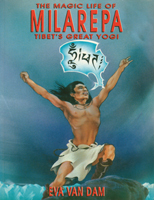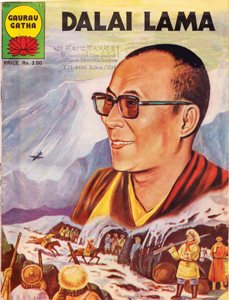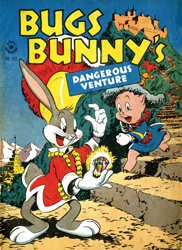Tin Tin did it, Lara Croft did it, and even Donald, Bugs, and Mickey did it. Travel to Tibet, that is—not the actual Himalayan country (since 1951 a part of the People’s  Republic of China) but the mythical place that has existed in the Western popular imagination since Europeans first arrived there 800 years ago.
Republic of China) but the mythical place that has existed in the Western popular imagination since Europeans first arrived there 800 years ago.
This gap between reality and illusion is the very Buddhist focus of Hero, Villain, Yeti: Tibet in Comics, at the Rubin Museum of Art, an exhibition that examines Western projections and fantasies about Tibet through comic books that feature it as a locale or a story element. The show—organized by the museum’s former chief curator, Martin Brauen—includes over 50 comics from the United States, Europe, India, and Japan dating from the 1940s to last year. In them, Tibet is depicted variously as a seat of ancient wisdom, a political cause, and, more recently, as a region grappling with 21st-century problems, which are often exacerbated by the stereotyping of its culture and inhabitants by the rest of the world.
Exotic descriptions of Tibet’s folk customs and unique form of esoteric Buddhism have filtered back to the West since the time of Marco Polo. Describing the denizens of the Chinese province of Tibet, Polo wrote in the 13th century, “Among this people, too, you find the best enchanters and astrologers that exist in all that quarter of the world; they perform such extraordinary marvels and sorceries by diabolic art that it astounds one to see or even hear of them.”
 The relatively recent conception of Tibet as a peaceful realm ruled by benevolent spiritual masters can be traced to the writings of Helena Petrovna Blavatsky (1831–1891), cofounder of the Theosophical Society. Blavatsky—who claimed she was a Tibetan Buddhist, although she had never been to Tibet— believed she was in psychic communication with a race of living Tibetan mahatmas, whose revelations formed the basis of her teachings.
The relatively recent conception of Tibet as a peaceful realm ruled by benevolent spiritual masters can be traced to the writings of Helena Petrovna Blavatsky (1831–1891), cofounder of the Theosophical Society. Blavatsky—who claimed she was a Tibetan Buddhist, although she had never been to Tibet— believed she was in psychic communication with a race of living Tibetan mahatmas, whose revelations formed the basis of her teachings.
This image was reinforced by books like James Hilton’s 1933 novel Lost Horizon, which describes a brotherhood of white sages living in a Himalayan paradise called Shangri-La, and by the 1956 publication of The Third Eye, which purported to be the autobiography of a Tibetan called T. Lobsang Rampa but in fact had been penned by an Englishman, Cyril Henry Hoskin.
Indeed, many ideas about Tibet taken up by the comics in the show, such as the belief that Tibetan monks were trained in the marital arts, are pure fantasy. Some, however, were at least partially based on Tibetan religious concepts such as the notion of the lama as an all-knowing, all-seeing spiritual adept with supernatural powers.
In the action comic The Green Lama (Kendell Foster Crossen and Mac Raboy, 1945–46), for example, the main character, American millionaire Jethro Dumont, is able to change from ordinary mortal to avenging superhero by reciting the Tibetan Buddhist prayer Om Mani Padme Hum. In The White Lama, Nos. 1–6, written by filmmaker Alejandro Jodorowsky and illustrated by Georges Bess (2000–2001), the son of Europeans living in Tibet is revealed, over the course of the series, to be an incarnation of the famed spiritual adept Milarepa. And in Weird Wonder Tales, Vol. 1, No. 11 (Stan Lee and Jack Kirby, 1975), two brothers travel to Shangri-La, only to find that, like reality itself, it is merely a reflection of their deepest fears and desires.

Not all the heroes in these comics are Western—in Midnight in Rhodes(Eric Boisset and Joseph Béhé, 1997), a Tibetan monk in Greece becomes embroiled in international espionage. And some aren’t human at all: 3 x 3 Eyes, No. 1 by Yuzo Takada (1995) is the first of a 40-volume story that follows the adventures of a Tibetan three-eyed demon, the last of her kind, who comes to Japan.
Tibet’s own folktales and stories of the lives of the Buddha and great yogis such as Milarepa are perfectly suited to the format of the comic book, a point the exhibition makes by pairing Eva Van Dam’s The Magic Life of Milarepa (1991) with a Tibetan thangka. Also included in the show is the electrifying Deer Park, the fifth volume of Osamu Tezuka’s eight-volume manga masterpiece, Buddha (2005). Even yetis make their appearance, most notably in Milo Manara and Alfredo Castelli’s gorgeous comic Snowman (1990), in which the abominable snowman is really a monk in disguise.
The show concludes with a section devoted to contemporary comics produced by Tibetans themselves.Yuru Pon (Taksam Jinpa Ngodup and Rapkar Wangchuk, 1997) recounts the story of the Tibetan resistance;Settling the Dispute Between Birds and Monkeys, a publication put out by the Chivam Foundation, is a teaching on morality for children; Jorgyal and Dhondup (Sonam Dhondup, 2001) follows a couple of Tibetan teenagers on their travels to Nepal and the United States.
For those without the time to read all the comic books available for perusal on the reading tables, the show also includes a short animated film that incorporates highlights from many of them. The film ends with a quote from the Dalai Lama that could easily double as an epigraph for the exhibition: “There are people who love Tibet and for whom all of Tibet is something entirely positive. On the other hand, there are people who want to show that Tibet had negative sides, and they make all of Tibet into something negative. Both views are of course distorted. I am convinced that the true meaning of education is to lessen the gap between reality and perception. This is what both science and Buddhist philosophy”—and now this show—“seek to do.”